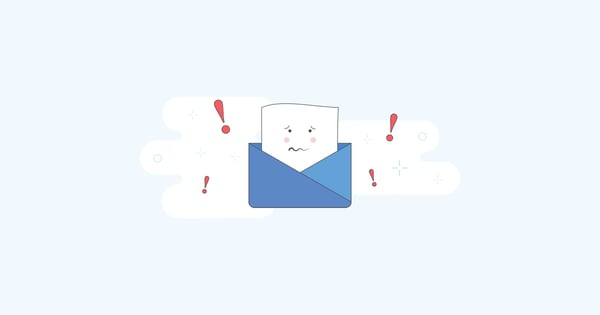I get it: You can’t please everyone. People opt-out of emails. That’s how it is. It’s not you, it’s them (scratch that: it is them).

Jokes aside, improving customer retention is a real concern for many businesses.
According to InsightSquared, it can cost you anywhere from 5-25 times more to acquire a new customer than it does to retain an existing one.
On the other hand, if you reduce your churn rate by as little as 5%, it’s possible to increase profits by 25% to 95%.
With email marketing driving more conversions than any other marketing channel, there’s never been a more important time to reduce email unsubscribe rates within your business.
The truth is, while you can’t always prevent readers from opting out of your emails, you can reduce the likelihood of them doing so with a few proven practices.
And in this article, I’m going to show what many influencers are doing to reduce email churn and nurture better a relationship with their audience, and how you can, too.
Shall we?

How to Reduce Email Unsubscribe Rates
This article is quite in-depth. To make life easier, I’ve broken each strategy down in more detail. Click a link below to jump to a particular section of interest.
1. Set the Expectation for When You’re Going to Email
2. Use a Combination of Single and Double Optins
Before we look at each strategy, let’s address the elephant in the room…
What Is a Good Unsubscribe Rate?
List building has grown in popularity in recent years.
And with it, many influencers have written about their favorite traffic sources and list building strategies (heck, we’ve been guilty of it, too).
However, there’s one thing many people don’t write about, something that’s on everybody’s mind:
What their average unsubscribe rate is.
Let’s be honest:
You can have the fastest-growing online audiences, but if people are opting out as often as others are opting in, you’ll have little to show for your efforts.
Before discovering how to reduce your email unsubscribe rate, then, it’s worth knowing what a good unsubscribe rate is (if there’s such a thing).
Let’s look at the numbers.
According to a recent study by SignUpTo, the average email unsubscribe rate is 0.52%:

This, of course, fluctuates greatly from industry to industry.
Mailchimp, in their research, found the average unsubscribe rate can be as high as 1.13% for telecommunications (no surprise there), and as low as 0.10% for daily deals/e-coupons.
So, if you’re below the 2%, as Campaign Monitor recommends, you’re doing something right.
And if you’re not…
The following strategies will help you get your rate down even further.
Reduce Email Unsubscribe Rates with These 7 Proven Practices
1. Set the Expectation for When You’re Going to Email
We’ve all been guilty of it…
You promise a friend you’ll meet them at a certain place at a certain time, but despite your best intentions, for one reason or another, you get caught up and keep your friend waiting.
If your friend is understanding they’ll forgive you. But if you do it consistently, over time, it will damage your friendship.
Why?
Because people value consistency in others.
When we say we’re going to do something and we don’t, we become inconsistent.
And when we become inconsistent, others begin to doubt our integrity.
Similarly, if you want to build trust with your audience, you need to set an expectation for when and how frequently you’re going to email.
And honor it.
Paul Jarvis is a perfect illustration of pacing his readers’ expectations.
On his landing page, he says he’s going to email you every Sunday…
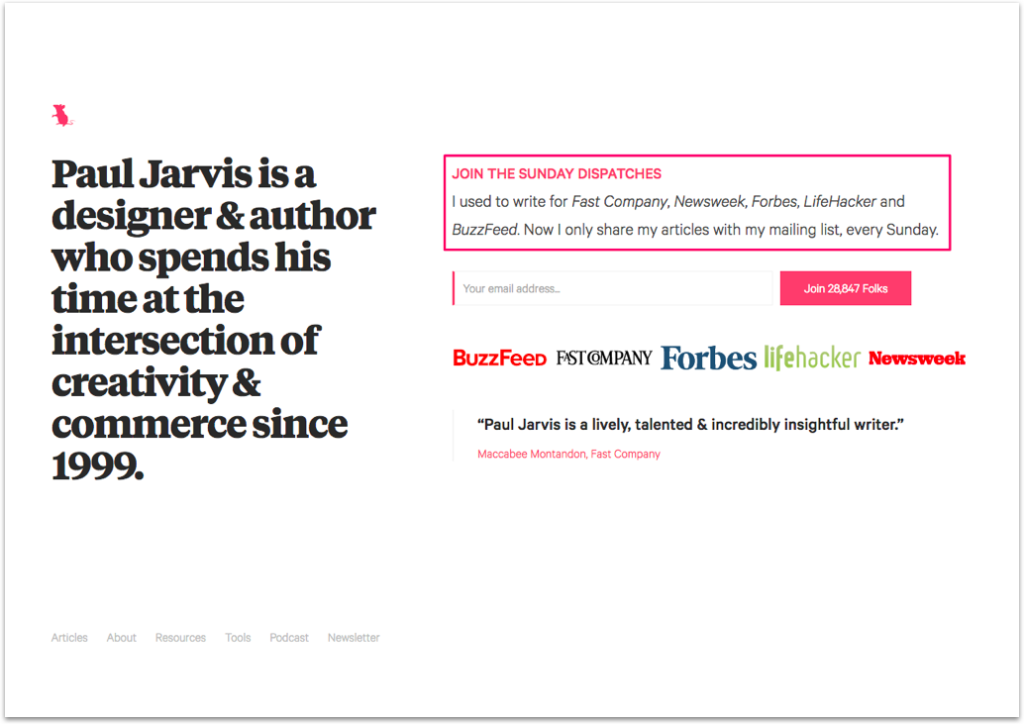
…and he keeps his word:

Granted, no two readers are alike; everyone has their own preference for how frequently they want emails.
TED knows this better than anyone.
On their newsletter page, they ask when you prefer to be emailed:

Takeaway: Set the expectation for when and how often you’re going to email your audience—and commit to it.
2. Use a Combination of Single and Double Optins
Speak to any marketer long enough and there’s one question that’s likely to come up:
Do you use single or double optins?
A quick refresher:
A single optin is when a visitor doesn’t need to confirm their subscription. They enter their email address and are immediately added to your list. A double optin is when a visitor is required to confirm their subscription via email.
Steve Chou, from My Wife Quit Her Job, grew his list size by 51.3% when he switched from a single to a double optin. On the other hand, research by Mailchimp has found campaigns with double optins have lower spam complaints and unsubscribe rates.
While there’s no definitive answer to which is more effective (it varies from person to person), both practices have their respective advantages (and disadvantages).
A good rule of thumb is this:
If you’re offering a content upgrade (like I’ve done in this article), use a single optin. If you’re collecting emails elsewhere (such as your homepage), use a double optin (especially if you’re sending them to a thank you page).
One of the challenges with using double optins is getting readers to confirm their subscriptions. In fact, as many as 20% of people who opt in on your site won’t confirm their email.
With the average person receiving as many as 122 emails per day, you need to cut through the noise if you want to get your emails opened.
There are a few ways to do that.
Derek Halpern from Social Triggers uses urgency in his subject line and body copy:
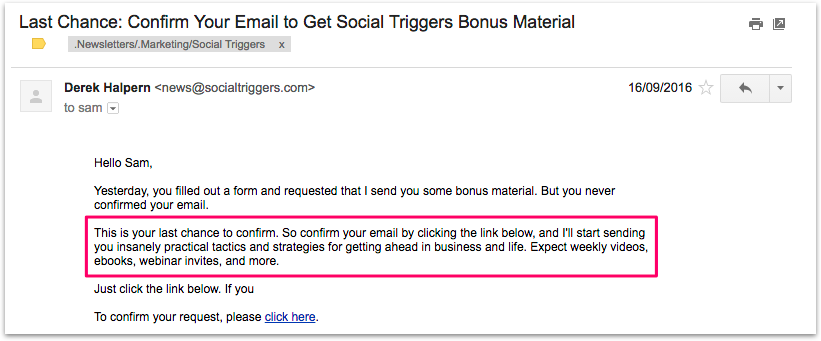
Krrb, on the other hand, give readers an opportunity to confirm they entered the email address correctly:
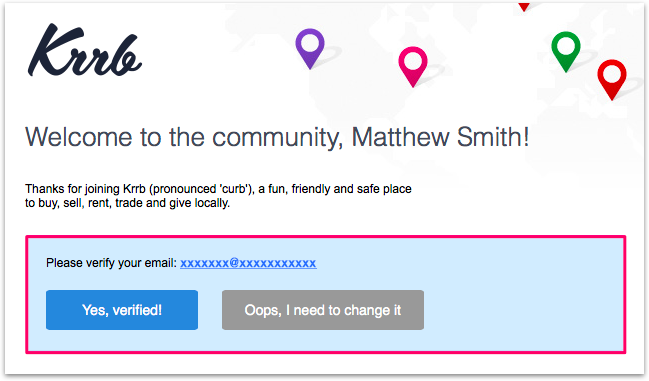
(Image Source: ReallyGoodEmails)
Give readers a good reason to confirm their email and it will give them an even better reason to stay on your list.
Takeaway. Use single optins for content upgrades and double optins for everything else, and try to stand out with your confirmation email.
3. Segment Your List by Interest
We’ve all experienced it…
And it sucks.
You read an article, opt in for a bonus or join a newsletter, and what do you get?
Content that’s completely irrelevant to what you originally signed up for.
In fact, it’s the third most common reason why people unsubscribe from emails:
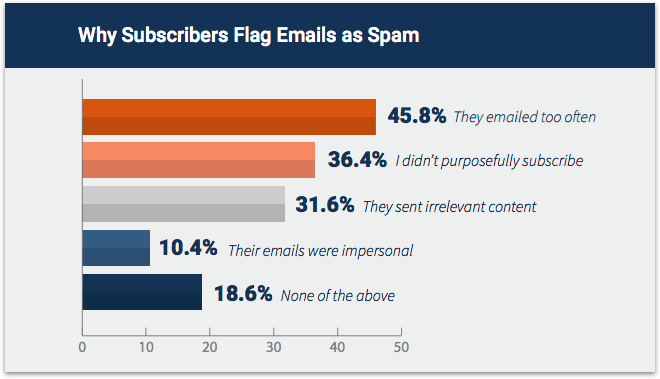
What’s the solution?
Send targeted emails using segments.
While sending targeted emails goes beyond the scope of this article, one of the best email marketing practices is to segment your subscribers immediately after joining your newsletter.
When you join the Smart Passive Income newsletter, Pat Flynn asks you which option best describes your online business activity:
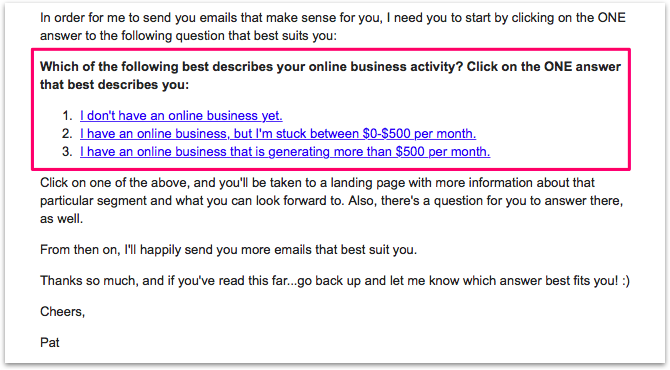
Moreover, he justifies why he’s asking, thus, enticing more people to click through.
From thereon, you’ll only receive emails that are relevant to your goals and challenges…
And you’re far less likely to unsubscribe.
Takeaway: Use segments in your email marketing software and send targeted emails to reduce readers opting out.
4. Use Normal Subject Lines
The online marketplace is noisier than ever.
And with more and more businesses competing for our attention every day, it’s getting harder and harder to cut through the commotion.
It’s no surprise, then, that many brands are resorting to questionable marketing tactics to get noticed.
And that includes using misleading email subject lines.
A few things worth avoiding:
- Using all caps. Writing in caps is the equivalent of yelling at your customers. If you wouldn’t consider doing the former, why would you consider doing the latter? Capitalizing words in your subject line not only comes across as obnoxious; it can trigger spam filters (more on that below).
- Using aggressive or provocative copy. If you’ve ever received an email with subject lines like “Do you hate me?” or “Open up! This is important,” you’ve probably done what most people do: unsubscribe. Bullying tactics don’t get you far in life; and they won’t get you far in marketing, either.
- Using “spam triggers”. What do words like “free”, “discount,” and “now” have in common? They all have the potential to trigger email spam filters. Sure, they might invite more opens, but they’re more likely to end up in the readers’ spam folder. To learn more about avoiding spam trigger words, read Neil Patel’s Definitive Guide to Marketing Automation.
- Using fake reply indicators. Including “re:” or “fwd” when you’re not replying or forwarding emails might appear clever (heck, it might even generate more opens), but it also misleads your audience and creates mistrust. It’s hard enough to build trust online, but it’s even harder to regain once it’s lost.
- Using false scarcity. Scarcity, when used honestly, can be an effective psychological trigger. But using it to create false urgency in your email marketing is a big no-no. People aren’t stupid; they know when something’s about to disappear forever and when it isn’t. Don’t trick your readers.
It’s important to mention here, writing normal subject lines isn’t about skimping on good copywriting practices. Rather, it’s about being as direct as possible with your audience, and letting your brand do the heavy lifting.
An effective subject line is only as good as the business that’s sending it.
And if you’re building a good reputation online and always nurturing relationships with your customers, writing normal subject lines is what will differentiate you from your competitors.
Takeaway. Write to your audience like you would a friend or work colleague (read: no sneaky tactics).
5. Revise Your Copy
We opt-out of emails every day.
But what few of us realize is, over time, we become conditioned to look for one word in the footer of every email:
Unsubscribe.
The phrasing of this option varies from one email marketing software to another, but the action doesn’t:
Unsubscribe + Click = No More Emails
Some companies, though, are challenging readers’ expectations by playing around with what’s become a standard expectation in email marketing.
Some, like Neil Patel, have reworded their copy from “Unsubscribe” to “Update my preferences”:

Others, like Helpscout, have changed the color of the anchor text and position of their opt-out link:

Let’s be clear, here:
This is NOT to trick your reader. Rather, it’s to give them other options before opting out (such as changing their email frequency).
Another effective copywriting practice is to remind readers how they got on your list, to begin with (this is especially important if you’re emailing infrequently as people often forget they even signed up).
Michael Hyatt outlines exactly how you got on his list at the footer of every email for this very reason:

Give readers a chance to opt-out, of course, but always give them more options so they’re less inclined to do so.
Takeaway: Revise your footer copy so readers have more choices when it comes to opting out of your newsletter. To learn more about good copywriting practices, read How to Write Powerful High-Converting Call-to-Actions.
6. Send a Follow-Up Email
It’s tempting to believe when a customer unsubscribes, you’ve lost them forever.
But that’s not entirely accurate.
Many businesses are now experimenting with sending follow-up emails to keep readers engaged beyond email.
Chris Guillebeau, for example, offers departing readers a chance to resubscribe to his list using an offer different to his original lead magnet:
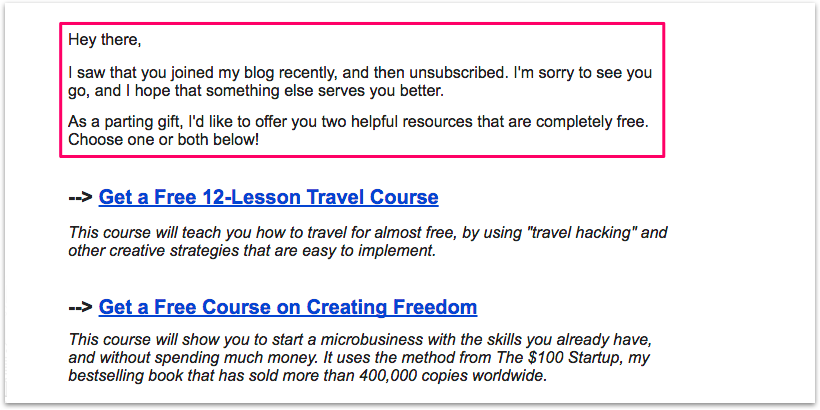
Sean McCabe, on the other hand, goes for a gentler request: asking for a follow on Twitter:
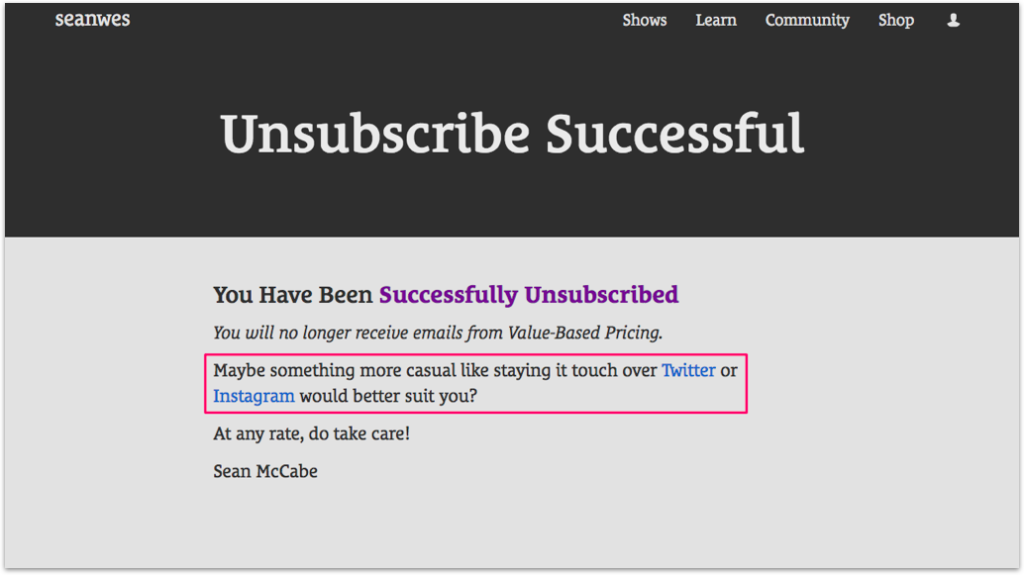
It’s important to mention here not to assume all readers unsubscribe because of you.
Sometimes, people’s priorities change. Other times, they’re inundated with too many emails (remember the above statistic?) Either way, look for opportunities to continue your relationship outside of email.
Who knows, one day, it might pay off.
Takeaway. Give departing readers a reason to stick around (even if that includes following you on social media).
7. Ask for Feedback
Another type of follow up email that’s popular with influencers is simply asking why a reader opted out.
Often, the reason might surprise you.
Many email marketing providers offer you an opportunity to survey your departing reader, but few business owners implement it properly.
Alex Turnbull from Groove was able to increase customer exit survey responses by 785% by switching from a survey to an open-ended question with split-tested copy:
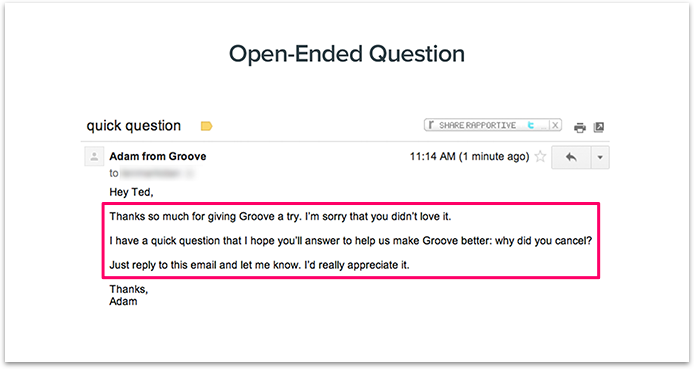
With those increased results, Alex was able to increase customer satisfaction and reduce churn (a concern for any SaaS business owner).
Asking for feedback can be a painful experience. That’s a given. But getting constructive feedback can not only improve user experience; it can iterate your customer onboarding process. Win. Win.
Takeaway. Follow up with departing readers by asking them why they unsubscribed. (Protip: split test how you ask them. As the above example demonstrates, how you ask is as important as why.)

Conclusion
Growing an email list is easy. Write original, high-quality content, generate traffic (through whitehat SEO techniques), and capture visitor email addresses.
But keeping your readers engaged and excited to open and read your marketing campaigns?
Well, that’s a different story.
It’s important to remember your readers are more than a name and an email on a .csv file; they’re real people, with goals, challenges, and pain points—just like you.
Consider that every time you do an email blast. Because if you do, and you have your audience’s best interest at heart, they’ll be more than happy to return the favor.

